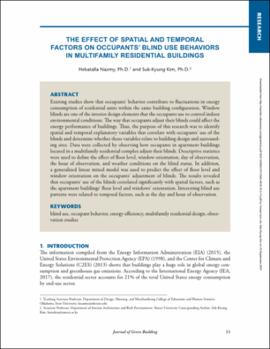| dc.contributor.author | Nazmy, Hebatalla | |
| dc.contributor.author | Kim, Suk-Kyung | |
| dc.date.accessioned | 2021-11-29T21:21:27Z | |
| dc.date.available | 2021-11-29T21:21:27Z | |
| dc.date.issued | 2021 | |
| dc.identifier | oksd_nazmy_effectofspatialandtemporalfactors_2021 | |
| dc.identifier.citation | Nazmy, H., & Kim, S.-K. (2021). The effect of spatial and temporal factors on occupants' blind use behaviors in multifamily residential buildings. Journal of Green Building, 16(3), 13-35. https://doi.org/10.3992/jgb.16.3.13 | |
| dc.identifier.uri | https://hdl.handle.net/11244/331278 | |
| dc.description.abstract | Existing studies show that occupants’ behavior contributes to fluctuations in energy consumption of residential units within the same building configuration. Window blinds are one of the interior design elements that the occupants use to control indoor environmental conditions. The way that occupants adjust their blinds could affect the energy performance of buildings. Thus, the purpose of this research was to identify spatial and temporal explanatory variables that correlate with occupants’ use of the blinds and determine whether those variables relate to building design and surrounding sites. Data were collected by observing how occupants in apartment buildings located in a multifamily residential complex adjust their blinds. Descriptive statistics were used to define the effect of floor level, window orientation, day of observation, hour of observation, and weather conditions on the blind status. In addition, a generalized linear mixed model was used to predict the effect of floor level and window orientation on the occupants’ adjustment of blinds. The results revealed that occupants’ use of the blinds correlated significantly with spatial factors, such as the apartment buildings’ floor level and windows’ orientation. Interesting blind use patterns were related to temporal factors, such as the day and hour of observation. | |
| dc.format | application/pdf | |
| dc.language | en_US | |
| dc.publisher | College Publishing | |
| dc.rights | This material has been previously published. In the Oklahoma State University Library's institutional repository this version is made available through the open access principles and the terms of agreement/consent between the author(s) and the publisher. The permission policy on the use, reproduction or distribution of the material falls under fair use for educational, scholarship, and research purposes. Contact Digital Resources and Discovery Services at lib-dls@okstate.edu or 405-744-9161 for further information. | |
| dc.title | Effect of spatial and temporal factors on occupants' blind use behaviors in multifamily residential buildings | |
| osu.filename | oksd_nazmy_effectofspatialandtemporalfactors_2021.pdf | |
| dc.description.peerreview | Peer reviewed | |
| dc.identifier.doi | 10.3992/jgb.16.3.13 | |
| dc.description.department | Design, Housing and Merchandising | |
| dc.type.genre | Article | |
| dc.type.material | Text | |
| dc.subject.keywords | blind use | |
| dc.subject.keywords | occupant behavior | |
| dc.subject.keywords | energy efficiency | |
| dc.subject.keywords | multifamily residential design | |
| dc.subject.keywords | observation studies | |
| osu.authorOrcid.uri | http://orcid.org/0000-0001-8560-0715 | |
